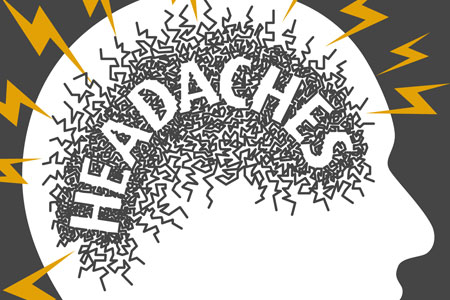
Headaches
Issue 89 February 2012
The excruciating pain experienced by millions is generally considered harmless by doctors; any regular sufferer however knows the debilitating impact on daily life. Sarah Jawad examines the types of headaches and their treatments.
Headaches are amongst the most common medical complaints. Defined as any sort of pain in the head or upper neck, they are the reason behind tens of thousands of visits to doctors each year. Although the majority of cases are harmless (albeit disruptive to everyday life), some are indicators of a more serious health problem. Headaches have a number of causes, which can be divided into primary and secondary. Their treatment depends on the type of headache, and usually takes the form of simple pain relief, unless an underlying cause can be established.
Types of Headaches
Primary Headaches
Primary headaches are the most common type, and include such things as tension headaches and migraines. They generally do not have an underlying cause; rather, their symptoms are mainly linked to pain, which can have a debilitating effect on a person’s life. There are three main types of primary headaches.
Tension Headaches—Also known as stress headaches, these are the most common type of headache. 90% of people will suffer from them at least once in their life, and they tend to be more common in females. They're characterised by mild to moderate pain, often described as a constant pressure, or as though one’s head is being squeezed in a vice. It tends to be present in both sides of the head at once, and may be associated with tenderness of the scalp, but, crucially, no nausea or vomiting. They can last from minutes to hours, or even days. 3% of the population suffer from chronic tension headaches, where they occur at least 15 days a month, for more than six months.
Migraines—8% of the UK population suffers from migraines. They are the cause of much misery, and alone cost the UK economy more than £200 million a year in lost production. It classically presents as a moderate-to-severe one-sided headache which is pulsating in nature. They can be associated with a number
of symptoms; many migraine sufferers report experiencing an ‘aura’ (such as strange sensations or visual disturbances) minutes before the onset of the headache, which itself can last for any length of time between 4 hours and three days. There are often associated symptoms, such as nausea and vomiting, and increased sensitivity to light, noise or smells. Some people find their headaches are triggered by certain foods or drinks, the main culprits being chocolate, cheese and caffeine. Migraines can affect both children and adults, although post-puberty they are again more common amongst females.
Cluster Headaches—Cluster headaches are a much rarer type of headache, which come on very rapidly and frequently, but are short lived. The pain is severeand always one sided, usually beginning around one eye, which may become watery and bloodshot. They tend to last between 15-160 minutes, and happen once or twice a day recurrently for several weeks; they often then subside for several months, before the next cluster.
Bookmark this |
|
Add to DIGG |
|
Add to del.icio.us |
|
Stumble this |
|
Share on Facebook |
|
Share this |
|
Send to a Friend |
|
Link to this |
|
Printer Friendly |
|
Print in plain text |
|


Comments
0 Comments